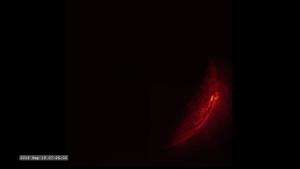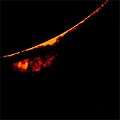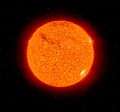Solar prominence

A prominence is a large, bright, gaseous feature extending outward from the Sun's surface, often in a loop shape. Prominences are anchored to the Sun's surface in the photosphere, and extend outwards into the Sun's corona. While the corona consists of extremely hot ionized gases, known as plasma, which do not emit much visible light, prominences contain much cooler plasma, similar in composition to that of the chromosphere. The prominence plasma is typically a hundred times cooler and denser than the coronal plasma. A prominence forms over timescales of about a day, and prominences may persist in the corona for several weeks or months. Some prominences break apart and may then give rise to coronal mass ejections. Scientists are currently researching how and why prominences are formed.
A prominence forms over timescales of about a day, and stable prominences may persist in the corona for several months, looping hundreds of thousands of miles into space.
The red-glowing looped material is plasma, a hot gas composed of electrically charged hydrogen and helium. The prominence plasma flows along a tangled and twisted structure of magnetic fields generated by the sun’s internal dynamo. An erupting prominence occurs when such a structure becomes unstable and bursts outward, releasing the plasma.
A typical prominence extends over many thousands of kilometers; the largest on record was estimated at over 800,000 kilometres (500,000 mi) long[1] – roughly the radius of the Sun.
Historical
The first detailed description of a solar prominence was in 14th-century Laurentian Codex, describing the Solar eclipse of 1 May 1185. They were described as "flame-like tongues of live embers."[2][3]
Prominences and Filaments
When a prominence is viewed from a different perspective so that it is against the sun instead of against space, it appears darker than the surrounding background. This formation is instead called a solar filament.[1] It is possible for a projection to be both a filament and a prominence. Some prominences are so powerful that they throw out matter from the Sun into space at speeds ranging from 600 km/s to more than 1000 km/s. Other prominences form huge loops or arching columns of glowing gases over sunspots that can reach heights of hundreds of thousands of kilometers. Prominences may last for a few days or even for a few months.[4]
Videos



.ogg.jpg)

Images
-

Solar prominences.
-

Detached Solar prominence.
-

A limb's flare and after-flare prominence.
-

Major eruptive prominence (Skylab 1973).
-

Solar prominence STEREO behind.
-

Solar prominence STEREO ahead.
-

Solar prominences (in red) visible around the edge of the sun during a solar eclipse
See also
| Wikimedia Commons has media related to Prominence. |
References
- 1 2 Atkinson, Nancy (6 August 2012). "Huge Solar Filament Stretches Across the Sun". Universe Today. Retrieved 11 August 2012.
- ↑ "1185: The first description of solar prominences". Great Moments in the History of Solar Physics. Université de Montréal. 2008. Retrieved March 30, 2015. See pdf version here (accessed 21 August 2015).
- ↑ Poitevin, Patrick; Edmonds, Joanne (2003). "Solar Eclipse Newsletter" (PDF) 8 (5). Patrick Poitevin. Retrieved March 30, 2015. Original text cited at "Лаврентьевская летопись". Izbornik. Leningrad: USSR Academy of Sciences. 1927. p. 396. Retrieved 30 March 2015.
- ↑ "About Filaments and Prominences". solar.physics.montana.edu. Retrieved 2 January 2010.
Further reading
- Galsgaard, K.; Longbottom, A.W. (1999). "Formation of solar prominences by flux convergence". Astrophysical Journal 510: 444. Bibcode:1999ApJ...510..444G. doi:10.1086/306559.
- Low, B.C.; Fong, B.; Fan, Y. (2003). "The mass of a solar quiescent prominence". Astrophysical Journal 594 (2): 1060. Bibcode:2003ApJ...594.1060L. doi:10.1086/377042.
- Golub, L.; Pasachoff J.M. (1997). The Solar Corona. Cambridge University Press. ISBN 0-521-48535-5.
- Tandberg-Hanssen, Einar (1995). The Nature of Solar Prominences. Dordrecht: Kluwer Acad. ISBN 978-0792333746.
| |||||||||||||||||||||||||||||||||||||||
